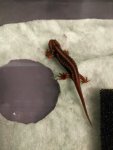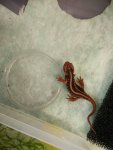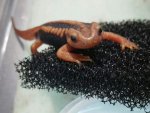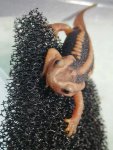The newly acquired male is very skinny and in comparison to the female lying underneath him, he looks like a twig. Luckily he has started feeding already and will be putting some weight on soon.
-
Did you know that registered users see fewer ads? Register today!
Male and Female T. Shanjing
- Thread starter yanger
- Start date
- No one is chatting at the moment.
-
Katia Del Rio-Tsonis:Dear All, I would appreciate some help identifying P. waltl disease and treatment. We received newts from Europe early November and a few maybe 3/70 had what it looked like lesions under the legs- at that time we thought maybe it was the stress of travel- now we think they probably had "red leg syndrome" (see picture). However a few weeks later other newts started to develop skin lesions (picture enclosed). The sender recommended to use sulfamerazine and we have treated them 2x and we are not sure they are all recovering. Does anyone have any experience with P. waltl diseases and could give some input on this? Any input would be greatly appreciated! Thank you.+1
-
Katia Del Rio-Tsonis:sorry I am having a hard time trying to upload the pictures- I have them saved on my hard drive... any suggestions-the prompts here are not allowing for downloads that way as far as I can tell. Thanks+1
Katia Del Rio-Tsonis:
sorry I am having a hard time trying to upload the pictures- I have them saved on my hard...
+1












